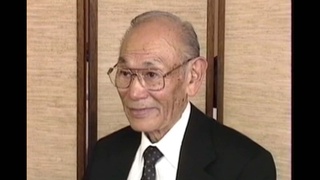Interviews
Meeting Hamako in Japan
And I got on a trolley and went to Kamakura and I saw the area there a little bit, and then when I went to get back on the trolley it didn't come, it didn't come. And there were a crowd of Japanese and a couple of soldiers—American GIs—were in this crowd waiting for the trolley and my wife, Hamako was...she had just come from having her eye operated on, she had some trouble with her eye. And she had a patch on it and she looked kind of weird, but I was eager to use my Japanese language so I spoke up to her anyway and at first she was very, you know, stand-off-ishy because good Japanese girls from nice families—which she was from a very high class family there—but I guess she was interested that I could speak the language.
Date: January 26, 2012
Location: California, US
Interviewer: John Esaki, Yoko Nishimura
Contributed by: Watase Media Arts Center, Japanese American National Museum







